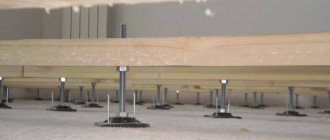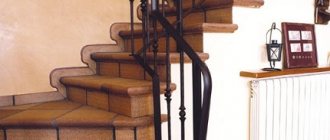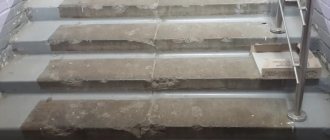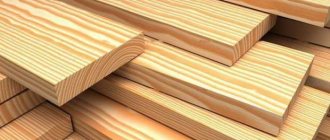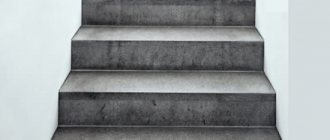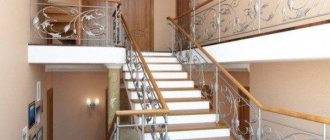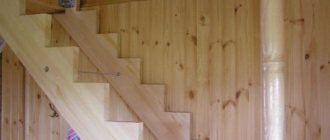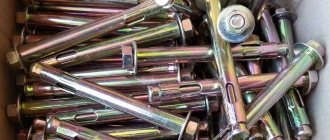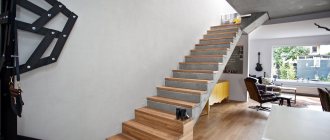Attaching wooden steps to a concrete staircase is a pressing task for many craftsmen who want to create a reliable and durable, comfortable and beautiful structure in their home. Finishing concrete stairs with wood allows you to preserve all the advantages of concrete and eliminate its disadvantages.
Concrete stairs, subject to professional design and proper creation, are considered the most reliable, resistant to various negative influences, durable, and fire-resistant. While a wooden structure can become brittle over time, it does not withstand changes in temperature and humidity so well and has a short service life.
Despite all its advantages, unfinished concrete is not suitable for a home: the material is cold and not very aesthetically pleasing. Therefore, the most successful option is to install wooden steps on a concrete staircase, which will give the entire structure a beautiful look, make it “warmer” and more pleasant to walk on.
A few important points when installing wooden steps on concrete:
- Solid wood steps are best installed on a plywood base, which will provide protection from temperature and moisture.
- When attaching elements with glue, you need to remember that wood and plywood (even with a layer of varnish) can absorb moisture, subsequently changing their appearance and size.
- It is best to choose a two-component, water-free adhesive for installation.
- When installing steps on a stringer, you need to ensure that the element is adjacent to the fasteners in the same plane, so that nothing bends or cracks.
- When choosing the parameters of the steps, you need to focus on the comfort of people and the design of the stairs.
Some standard element parameters:
- The thickness of the finishing steps is 22 millimeters, subject to additional preparation. 35 millimeters is enough for any concrete staircase, 45 millimeters does not require leveling the base.
- The glue consumption is directly affected by the degree of surface roughness, the number of bumps, slopes, cavities, etc.
- Solid wood steps must be installed on a prepared base.
- When choosing any parameters, you need to focus on the design, calculations and optimal characteristics for comfort in operation.
Design and shape options
A step is the main component of a flight of stairs. According to experts, the minimum permissible number of steps in a staircase is 3, and the maximum is 18. There are three main criteria that determine the type of steps.
By location:
- Frieze - there are upper and lower ones. The first one ends the climb at the upper level, and the second one starts it at the lower level.
- The rank and file are all the other steps that form the march.
By geometry:
- Straight - ordinary elements that have equal depth along the entire length of the tread. The predominant number of flight stairs consists of them, especially for direct ascents.
- Winders are elements used in modeling turning marches. They are used in screw structures and have unequal tread depths: narrower at the inner edge and wider on the opposite side.
Types of steps
Depending on the presence or absence of risers, stairs are:
- Open - have steps in which there is only a horizontal part or tread. The distance between structural elements remains empty.
- Closed - have steps with risers.
In addition, the elements of a flight of stairs differ from each other in shape:
- Direct. They look like a rectangle. This type is not recommended for screw structures. You can attach such elements in any way.
- Round ones are characterized by radial edges. They are often used to decorate a porch on the street and as the lowest step when climbing.
- Semicircular steps are also used when entering a house from the street. They have a semicircle on one side and a straight line on the other.
- Trapezoid-shaped elements form the design of spiral staircases and rotary staircase models.
Steps are made from different materials: wood, concrete, metal, glass, brick, veneered plywood. According to experts, it is easiest to work with wood: the blanks are easy to make and the tools for making them are quite easy to use.
Advantages and disadvantages of interfloor stairs in a private house
In a building with more than one floor, there is always at least one staircase. The only way to avoid dealing with them is to build a one-story house. Why might the prospect of being limited to one floor seem tempting to a not very experienced builder?
- Reluctance to delve into the complexities of design
The manual for making stairs contains a whole list of rules and prohibitions, a long formula for calculation and many incomprehensible words. It can be scary. But there is no need to be afraid. If you wade through a bunch of mysterious terms, it turns out that the problem can be solved without two higher educations.
This is a significant part of the house, which indicates the idea of style and sets the desired mood for the interior.
- Saving usable space
At first glance, the space occupied by the staircase simply disappears. You can’t place cabinets there, you can’t put another guest sofa, you can’t set up a workspace. At the same time, it, like the rest of the house, has to be heated, lit, and spent time and effort cleaning it.
On the other hand, a staircase and, accordingly, a second floor is an opportunity to double the living space without encroaching on the space of the garden area. Therefore, talk about saving space seems very controversial.
Often today it is distinguished by greater functionality, since in addition to its main purpose it also carries other loads.
- Saving money
It’s difficult to argue here. The construction of a one-story cottage costs less than the construction of a two-story cottage of the same area using the same building materials.
Of the three arguments against stairs, two do not stand up to scrutiny. Conclusion: It is foolish to avoid this design element at all costs. It allows:
- increase the number of residential premises;
- leave more free space in the garden area;
- make the interior more interesting, unusual, aesthetically attractive.
It is often an element of zoning space, delimiting it into separate functional areas.
In most cases, the question of whether to make a ladder or not is, in principle, not worth it. Simply because it is immediately obvious that all the planned premises will not fit on one floor.
Types of wood for steps
Reliability, aesthetic appearance and durability of elements directly depend on the characteristics of the material. The following requirements apply to the tree:
- Structural uniformity of wood fibers. High-quality workpieces are free of cracks, delaminations, knots and other defects.
Unacceptable defects in raw materials
- Integrity. Before buying wood, you should pay attention to ensure that there is no rot or traces of wood-boring beetles on the workpieces.
- Humidity is within normal limits. This figure should not exceed 12%. Otherwise, the boards should be thoroughly dried before use, avoiding direct sunlight.
It is recommended to make elements that will be subject to constant load from solid wood. If this is not possible, then it is permissible to use laminated veneer lumber.
Different types of wood are suitable for making steps with your own hands. But the most popular are:
- Pine. This is an inexpensive and easy to process material. It is characterized by a low degree of hardness, therefore, when working with it, you can use the most common tools. In addition, pine is always available: it is not particularly difficult to find lumber of the desired size and shape. The disadvantage of pine products is considered to be low wear resistance and the appearance of yellowness on the tree a few years after installation.
- Birch. It is distinguished by its durability and special textured pattern. Unlike pine, it is more difficult to process, but birch parts will last much longer. When using birch in construction, the selection of blanks is especially difficult. It is almost impossible to find large boards of uniform color and without defects. Therefore, experts recommend covering the composite structure with veneer.
- Larch. Steps made from this type of wood do not deform, do not shrink, or rot due to the high content of tannins. The main disadvantage is the high price.
- Beech. It is considered a more suitable material for stairs inside the house. The appearance of the blanks is beautiful color and texture. The main disadvantage of wood is its instability to temperature fluctuations and humidity. Even beech blanks soaked in varnish will change shape under the influence of natural factors.
- Ash. It has a high degree of hardness and is therefore ideal for the production of steps. However, due to the complex processing and bright texture, the material is not to everyone’s taste.
- Oak. Wooden steps for stairs made of solid oak are the best choice. Such steps will last for decades. The only disadvantage of this material is its high cost.
Preparing for work
To simplify the installation of the stairs as much as possible, you need to prepare for work. To install a wooden structure, you will need tools and materials.
The best wood options for stairs are oak, maple, larch and ash. The fact is that they are much less susceptible to shrinkage and deformation of wood. In addition, these rocks have excellent density, so they cope well with mechanical loads and surface abrasion. Under no circumstances should you use soft, porous or coniferous wood, such as pine. They won't last long.
Preliminary work can be divided into 3 stages:
- design (project creation);
- selection of all materials;
- preparation of tools.
At the first stage, you need to prepare a high-quality diagram. Creating a drawing is done on paper or in a special program on a PC. If the location for installing the staircase system is clear, then before you begin preparing the details of the selected option, you need to make accurate calculations, study the prepared drawing and use all the acquired characteristics for further work. Based on the calculations, consumables are selected.
Calculation of stair steps
Having decided on the material of the workpieces, it is necessary to begin making calculations.
Geometric parameters of steps
Dimensions of steps
When manufacturing steps, standard dimensions are used:
- The height of the step is equal to the length of the riser and varies from 150 to 220 mm.
- The depth of the element is the segment from the outer edge of the tread to the riser. It should be such that the foot is completely on the tread. The minimum depth is 25 cm, the maximum is 40 cm.
It should be noted that the depth of the step may not be the same along the entire length of the tread. This is observed in spiral and rotary models. It is larger on the outer edge than on the inside. The depth of the tread remains unchanged only in the center of the step. However, this disadvantage can be dealt with in two ways: using protruding steps or eliminating risers.
- The width of the step is the distance between the edges of the tread. This indicator depends on the intensity of traffic. The standard value is from 900 to 1000 mm. If the traffic is busy, then the flight of stairs can be increased to 1.5 m.
- The thickness of the tread is in a ratio of 1:20 to the width of the step. So, with a width of 900 mm, the tread thickness will be 45 mm. It should be remembered that the minimum permissible tread thickness is 35 mm.
- The thickness of the riser varies from 1.8 to 2.5 cm.
Based on the data obtained, the angle of inclination of the structure and the number of steps are calculated.
Optimal slope of the stairs
The most convenient inclination of a staircase structure is recognized to be a slope from 23 to 37 degrees. The usable area occupied depends on the steepness of the structure. Naturally, steeper structures require significantly less space than flat ones.
Selecting a slope for a structure
Stairs with a slope of 45 degrees are quite difficult to climb, and with a slope of less than 23 degrees they can be replaced with a ramp.
Calculation of the number of steps in a march
To get the exact number of steps in the staircase, you need to divide the height of the floor by the height of one step. The number of marches does not matter at all. It should also be noted that the floor height refers to the distance from the floor covering to the floor on the second floor, taking into account the thickness of the covering.
Knowing the staircase structure and the height of the upper floor, the number of steps can also be determined using a graphical method. Then, using safety formulas, find the width of the tread.
The dimensions of the steps must be taken based on the safety formula
Having decided on the scale, a flight of stairs is drawn on graph paper. Errors that appeared as a result of rounding are distributed to the frieze stage of the lower tier. All remaining steps are made the same size.
Calculation of riser height
The final stage
At the final stage, the symmetry of the entire structure, the stability of the connections are checked, and a number of manipulations are also performed:
- grinding each element;
- impregnation with special compounds to minimize the likelihood of fire, the formation of rot, and damage by wood-boring insects;
- tinting the varnish coating.
Despite the relative cheapness, the stairs should not be painted. But the final decision is still made by the owner of the house, focusing on the overall stylistic design.
What do we need to know about the future staircase? The main thing is the height between floors. And the main rule for constructing a staircase for ease of future use is that the length of the steps should be 30 cm and the height 20 cm. If these rules are followed, then walking will be comfortable. For the originals who want to make the step shorter or higher, I say right away - you will break your legs. For clarity, let's look at a simple example.
How to make steps from wood with your own hands
Making steps for stairs from wood requires the following set of tools:
- electric plane;
- a circular saw;
- grinding machine;
- router for edge processing.
Prepare templates of the required size and transfer them to the workpieces. Then cut out the treads and risers. When performing this work, difficulties may arise only when cutting out the turning steps due to their unconventional shape.
The resulting parts should be treated with protective agents and then installation should begin.
Installation of wooden steps
There are four types of fastenings for wooden staircase steps:
- Metal carcass. A tread is secured to a corner, channel or metal plate.
- Stringer or bowstring made of wood, plywood. The tread is placed on the ridges and fixed with nails, bolts, and glue.
Stringer mounting options
Methods of attaching to a string
- The central pillar on which the steps of screw models are attached. By the way they are placed, they resemble a spiral with equal distances between the steps.
Installation of screw steps - Console or Bracket. The cantilever type of fastening involves fastening protruding steps to the reinforcement using welding or anchors.
Let's assume that you want to attach elements to stringers. Then the tread and riser are connected in one of the following ways:
- screws;
- using a groove that is cut into the tread at the intended junction with the riser;
- by installing an auxiliary triangular rail that acts as a support.
Attaching to a stringer
Whichever method you choose, it is recommended to additionally glue the parts being connected to ensure greater strength.
In the case of attaching stair steps to a bowstring, they can be fixed using a block, a metal corner or a groove.
The final stage after installing the steps is finishing them with plinths.
Metal staircase with wooden steps
The wooden elements are attached to the metal base using holes made at a distance of 150 mm. In this case, it is necessary to make an indentation from the edge of 20 mm.
A plywood backing will eliminate errors that arise when welding metal elements
When welding metal components, errors could be made that caused minor differences in height. In this case, to eliminate irregularities, a substrate is glued to the frame. Plywood with a thickness of 10 mm is suitable for this.
Metal structure cladding
To ensure that the substrate is securely fixed, self-tapping screws are additionally used. Polyurethane foam is not suitable for these purposes. After hardening, it will begin to crumble under the influence of load, which will lead to loosening of the steps.
The wooden tread is pressed against the plywood with clamps and secured with self-tapping screws. To make a staircase with a metal frame look attractive, craftsmen advise making steps with protrusions. They will hide the ugly metal frame.
Concrete staircase with wooden steps
Despite their strength, concrete structures cannot boast of beauty. Therefore, such structures are usually laminated or decorated with wood. Wood cladding is not cheap, but the results are excellent.
Before you begin installing the steps, you need to wait until the structure is completely dry. Otherwise, the sheathing will be saturated with moisture from the wet concrete and deform in the future. The staircase must dry for at least three weeks.
After the concrete mixture has completely dried, installation can begin.
The success of the operation largely depends on how carefully the formwork is prepared. But even in the best case, distortions and irregularities appear, which can be easily eliminated with the help of a screed. After it dries, the surface is cleaned and treated with a primer.
To completely level the concrete surface and create a moisture-proofing layer, sheets of plywood are glued onto a special mastic, and additional fastening is done with dowels.
Plywood eliminates possible geometric inaccuracies of the concrete base
Having carried out the preparatory work, they begin to install the steps. The treads and risers are connected to each other using grooves made in all parts.
Installation of steps begins with the lowest riser, which is bolted to the floor. They are screwed into the end of the part so that the caps stick out 8 cm. Then they are cut off and marks are placed on the floor where they will go.
Dowel connection
Holes are made in the marked areas and filled with epoxy resin. Finally, the riser is attached. After this, a tread with another riser attached to it is placed on the plywood with glue. To make the product stick better, it is recommended to use a weight.
Placement of load-bearing beams
First, cutouts for the steps are prepared on the support beam if the staircase will be installed on strings. These cutouts should be located at least 5 centimeters from the edge. The grooves of the supporting elements are mirrored.
If the ladder is installed on stringers, then the cutouts are created according to a different scheme:
- dividing the beam into two equal parts;
- using a corner and following the drawing, thanks to the corner, future places are marked with a cutout in the upper half;
- cutting out the marked recesses;
- performing similar operations for the second beam.
After this, the support beam is installed where the stairs are planned to be installed. Moreover, the connection of timber and load-bearing beams is carried out in two ways:
- making a cutout in the beam;
- designing small grooves in the support bar, it is into them that the beams will be inserted.
Next comes the actual installation of the stringers:
- installation and fastening of the bar with steel anchors in the place where the staircase will end;
- connection on the second floor of all load-bearing elements with timber;
- tightly pressing the stringers on the floor to the support bar;
- securing the beam with archers.
Installation of the structure on bowstrings is carried out in a different way. First, the steps are inserted, and after that the ladder must be moved to the wall and fixed on the bars.
Steps for outdoor entrance staircase
A neat staircase on the porch has not yet lost its relevance. Solid wood species that are resistant to constant external influences are suitable for its manufacture. As a rule, this is oak, ash, maple, beech.
To protect against external influences, the street structure is treated with protective agents
In order for the structure to serve faithfully for many years, it must be protected from natural factors such as moisture and temperature changes. Elements in contact with the ground are impregnated with oils, and the open surfaces of the steps are treated with drying oil and covered with paint or varnish.
The street staircase should be periodically inspected and, if necessary, rotten areas of the structure should be eliminated.
Exterior wooden staircase design
The facing of stairs on the street has its own specifics. During the construction of the porch, metal bookmarks are left in the concrete, to which wooden steps will later be attached.
Video
Video about how the process of cladding concrete steps with wood occurs.
“How to cover a concrete staircase with wood?” - it is impossible to answer this question: “Simple!” This is a task for professionals. Independent installation of a flight of stairs is possible only if a builder, an amateur or a leisurely expert in the intricacies of working with wood, measurements, and installation takes up the task.
In all other cases, feel free to call a surveyor to your home, he will help you determine the exact price for such work. A construction company is a guarantee of beautiful work, done technologically correctly, which also guarantees your safety.
Maybe,
Treatment of steps with protective agents
Now you know how to make your own steps for a wooden staircase. Next, it is necessary to ensure their protection from damage and exposure to external and internal factors. Special means are intended for these purposes. These include impregnations, varnishes and paints.
Impregnation protects wood from damage
Impregnation is a liquid that penetrates the wood structure and gives it certain properties. The most common are:
- Fire-retardant compounds that increase the resistance of wooden elements to high temperatures.
- Antiseptics are products that protect wood from fungi and bacteria. These compounds prevent rotting of the material even in conditions of high humidity.
- Complex impregnations that simultaneously perform the functions of tinting and disinfection.
In order for the impregnation to be evenly distributed over the wooden workpiece and deeply saturated, it is recommended to apply it to the products before installation.
Paint and varnish products are used at the very last stage of work. The only exceptions are the components of the railing, which are more convenient to paint and varnish disassembled.
Alkyd and alkyd-urethane products are suitable for painting marches; enamels are suitable for railings and risers. It is customary to coat stairs indoors with alcohol-based varnish with a matte or glossy composition. Stair structures from the street are treated with nitrocellulose products.
Material selection
To make wooden elements with your own hands, use a dried solid wood or, to save money, a glued board with a uniform structure, without knots and foreign inclusions. Here are some general rules:
When selecting wood, the average temperature and humidity parameters of the microclimate in the premises, the load on all elements, the frequency of use of the stairs and other parameters important to the owners are taken into account.
Once the drawing has been prepared and the necessary material and tools are available, you can proceed directly to the manufacture of the lift. Straight wooden stairs for a summer house to the second floor are the most convenient and easy to construct, so using a specific example we will look at how to make just such a structure, the basis for which will be stringers.
